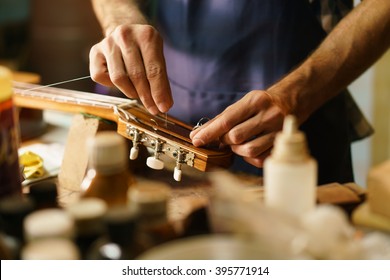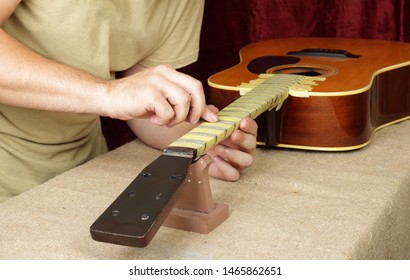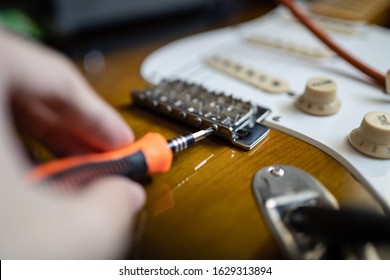How to make the tone of a guitar (or guitar) will sometimes be out of tune even after you tune your guitar, which means that the guitar is badly covered. To check this, you need to separate a harmonic note in the 12th house (lightly touch the rope in the 12th house and rotate) and the common note a high octave (press the rope in the 12th house and stroller). . Except for the guitar in the right tone, each house notes are composed on a string equivalent to a colored reference or natural music range, which adjusts the length of the string in the stand. The color musical scale and natural music scale are the same, so you can use an air instrument to adjust the tone. In tone, the 12th house of the rope should theoretically be a higher house than the loose rope note and the seventh house note should be the same as the seventh harmonica. The process is similar for guitar, guitar and bass.
Read all the tips and warnings at the bottom of this page. There are several things you should know before starting this process.
 1. Tune the instrument strings as you want them to last. Tune all chords directly with the tuner. Don't do tuning based on 5th house or any harmonics at this time. For acoustic or semi-acoustic devices: Use a programmable electric tuner that you can connect directly to the instrument. Note Use the descriptive equation below to find out frequencies for n programmable tuners for acoustic devices: very quiet (and silent) rooms and use a microphone tuner. Remember, adjust the instrument as you need it. If your band plays Drop D, Standard Ab, Modal G, or any other tuning, you must adjust your instrument to the same pitch. Drop D tuning is better than standard as it has lower string tension. Bass player: During this process you should use a reed, even if you don't normally touch one. The way we work well with our fingers at the time of playing the string, but it is not sufficient (or consistent) for this process For all instruments: Tune the instrument several times the tension in each tone. When changed, it can change the flexibility of the hand, and tune your other wires. Continue this step until each string is tuned as close to perfection as possible. When you have finished this part, go to the next step.
1. Tune the instrument strings as you want them to last. Tune all chords directly with the tuner. Don't do tuning based on 5th house or any harmonics at this time. For acoustic or semi-acoustic devices: Use a programmable electric tuner that you can connect directly to the instrument. Note Use the descriptive equation below to find out frequencies for n programmable tuners for acoustic devices: very quiet (and silent) rooms and use a microphone tuner. Remember, adjust the instrument as you need it. If your band plays Drop D, Standard Ab, Modal G, or any other tuning, you must adjust your instrument to the same pitch. Drop D tuning is better than standard as it has lower string tension. Bass player: During this process you should use a reed, even if you don't normally touch one. The way we work well with our fingers at the time of playing the string, but it is not sufficient (or consistent) for this process For all instruments: Tune the instrument several times the tension in each tone. When changed, it can change the flexibility of the hand, and tune your other wires. Continue this step until each string is tuned as close to perfection as possible. When you have finished this part, go to the next step.
 2. Adjust your action. If you are ready to increase or decrease the action of the string (the distance between the strings and the arm), then you must do it now. If the rope is scrapering (making noise), then move it up. Pick up so that it stops when something plays in strut, the tuning of the note can quickly and temporarily change, making the rhythm very difficult. This change in pitch can make the note more intense than it is. In addition, occasional skewing produces some harmonic notes that may reduce the sanctity of notes in higher houses - notes in the tenth house may sound louder. The smaller the magnitude and duration of farting in adjacent frets, the less necessary changes in action. If you take action after completing the lightness process, you will have to do all the work again. If you have changed the action on some rope, repeat the second step. Better guitars and guitar strings can be placed closer to the arm with less gag. The closer the arm is to the rope, the less pressure it needs to press and can be reduced, but in the event that it becomes more difficult to provoke the flames. Allow the ropes to be closer to the houses - if there is a breakup, extend the distance a bit. It may be that there is a bit of entrenchment in houses above the 12th — in this case, it is not so necessary to raise the wire. The lightness error due to string stretching is (t 2+ (t (2 y i / s)) 2) 1/2-t, where t is the number string tension i loose, and y i is the distance between the rope and the 12th house. This equation tells us that as the tension of the string in the vowel improves t decreases and the distance y i is the minimum between the rope and the 12th house is necessary to maintain that y i is as short as possible. The first string is fully toned. If the distance y i between the ropes and the casa is too large, it is impossible to atone for perfection.
2. Adjust your action. If you are ready to increase or decrease the action of the string (the distance between the strings and the arm), then you must do it now. If the rope is scrapering (making noise), then move it up. Pick up so that it stops when something plays in strut, the tuning of the note can quickly and temporarily change, making the rhythm very difficult. This change in pitch can make the note more intense than it is. In addition, occasional skewing produces some harmonic notes that may reduce the sanctity of notes in higher houses - notes in the tenth house may sound louder. The smaller the magnitude and duration of farting in adjacent frets, the less necessary changes in action. If you take action after completing the lightness process, you will have to do all the work again. If you have changed the action on some rope, repeat the second step. Better guitars and guitar strings can be placed closer to the arm with less gag. The closer the arm is to the rope, the less pressure it needs to press and can be reduced, but in the event that it becomes more difficult to provoke the flames. Allow the ropes to be closer to the houses - if there is a breakup, extend the distance a bit. It may be that there is a bit of entrenchment in houses above the 12th — in this case, it is not so necessary to raise the wire. The lightness error due to string stretching is (t 2+ (t (2 y i / s)) 2) 1/2-t, where t is the number string tension i loose, and y i is the distance between the rope and the 12th house. This equation tells us that as the tension of the string in the vowel improves t decreases and the distance y i is the minimum between the rope and the 12th house is necessary to maintain that y i is as short as possible. The first string is fully toned. If the distance y i between the ropes and the casa is too large, it is impossible to atone for perfection.
 3. Lots left for tune? Put your finger on the 12th house and pick up the rope. Choosing should be liberal, neither strong nor weak. When choosing, press your finger at home, just enough to stop the hilling. Even with a standard scale that is possible (especially on guitar), bending the string several hundredth degrees will make it very difficult to stretch. This is usually not a problem when you are playing, but for this process you have to be completely accurate. Touch the string with your finger on the 12th house and look at the tuner. If your tuning is too fast or too severe then your lightness is incorrect and adjustments will be required.
3. Lots left for tune? Put your finger on the 12th house and pick up the rope. Choosing should be liberal, neither strong nor weak. When choosing, press your finger at home, just enough to stop the hilling. Even with a standard scale that is possible (especially on guitar), bending the string several hundredth degrees will make it very difficult to stretch. This is usually not a problem when you are playing, but for this process you have to be completely accurate. Touch the string with your finger on the 12th house and look at the tuner. If your tuning is too fast or too severe then your lightness is incorrect and adjustments will be required.
 4. would have been fine. If, when you play the rope in the 12th house, the note is very sharp, the bridge is very close to the center of the rope, and you need to leave the vibration length of the rope still. How to decide: go beyond the scale Move the bridge for (by turning the screwdriver towards the guitar arm). If the note becomes too severe by touching the rope in the 12th house, the bridge is too far from the center of the rope, and you need to release the vibration length of the rope. Will be needed. Use the electric tuner to compare the 12th house note with the corresponding 12th harmonic. How to repair: Move the scale (turning the screwdriver towards you) closer to the bridge. This will leave the proper tone in the entire hand
4. would have been fine. If, when you play the rope in the 12th house, the note is very sharp, the bridge is very close to the center of the rope, and you need to leave the vibration length of the rope still. How to decide: go beyond the scale Move the bridge for (by turning the screwdriver towards the guitar arm). If the note becomes too severe by touching the rope in the 12th house, the bridge is too far from the center of the rope, and you need to release the vibration length of the rope. Will be needed. Use the electric tuner to compare the 12th house note with the corresponding 12th harmonic. How to repair: Move the scale (turning the screwdriver towards you) closer to the bridge. This will leave the proper tone in the entire hand
 5. Check fit After making an adjustment on the bridge, you should repeat the second step. Make sure the instruments are all still fully tuned. Once you complete the second step again, put your finger on the string back to the 12th house, which you adjust and check on the tuner. You will see that it is not already giving such a result. If the 12th house note is not fully tuned, but has a loose rope, you should repeat step 4 until both are seen. Tune the loose string and then check the 5th house note using a tuning fork. If the note is a little too sharp in the 5th house, move the bridge one third of a millimeter down. Some songs play on the string and adjust the length of the string on the bridge accordingly if the latens don't look good. If that is correct, then tune the notes of the houses first by adjusting the string tension you are working with that rope - then compare the grade to the 12th house of the string using a colored tuner. Compare chord notes with colored scales, and if most treble notes are too sharp in relation to the sharpened notes, increase the raga by about 0.2 mm, or if it is too severe, shorten the chord. Repeat this until all notes up to 12th house are almost identical to the reference notes. The most accurate pronunciation of a string occurs when the houses of the 12th, 16th, and 19 hours are pressed, with a sound equal to their respective harmonic notes. Watch the tuning by playing the melody of "Jackson's Mama's Pearl" on a string
5. Check fit After making an adjustment on the bridge, you should repeat the second step. Make sure the instruments are all still fully tuned. Once you complete the second step again, put your finger on the string back to the 12th house, which you adjust and check on the tuner. You will see that it is not already giving such a result. If the 12th house note is not fully tuned, but has a loose rope, you should repeat step 4 until both are seen. Tune the loose string and then check the 5th house note using a tuning fork. If the note is a little too sharp in the 5th house, move the bridge one third of a millimeter down. Some songs play on the string and adjust the length of the string on the bridge accordingly if the latens don't look good. If that is correct, then tune the notes of the houses first by adjusting the string tension you are working with that rope - then compare the grade to the 12th house of the string using a colored tuner. Compare chord notes with colored scales, and if most treble notes are too sharp in relation to the sharpened notes, increase the raga by about 0.2 mm, or if it is too severe, shorten the chord. Repeat this until all notes up to 12th house are almost identical to the reference notes. The most accurate pronunciation of a string occurs when the houses of the 12th, 16th, and 19 hours are pressed, with a sound equal to their respective harmonic notes. Watch the tuning by playing the melody of "Jackson's Mama's Pearl" on a string
Enjoy, after finishing with the instrument, play a nice big chord. Listen to all the other tones you couldn't produce! Now turn on the distortion and notice how your guitar looks more powerful.
The steps
Read all the tips and warnings at the bottom of this page. There are several things you should know before starting this process.
 1. Tune the instrument strings as you want them to last. Tune all chords directly with the tuner. Don't do tuning based on 5th house or any harmonics at this time. For acoustic or semi-acoustic devices: Use a programmable electric tuner that you can connect directly to the instrument. Note Use the descriptive equation below to find out frequencies for n programmable tuners for acoustic devices: very quiet (and silent) rooms and use a microphone tuner. Remember, adjust the instrument as you need it. If your band plays Drop D, Standard Ab, Modal G, or any other tuning, you must adjust your instrument to the same pitch. Drop D tuning is better than standard as it has lower string tension. Bass player: During this process you should use a reed, even if you don't normally touch one. The way we work well with our fingers at the time of playing the string, but it is not sufficient (or consistent) for this process For all instruments: Tune the instrument several times the tension in each tone. When changed, it can change the flexibility of the hand, and tune your other wires. Continue this step until each string is tuned as close to perfection as possible. When you have finished this part, go to the next step.
1. Tune the instrument strings as you want them to last. Tune all chords directly with the tuner. Don't do tuning based on 5th house or any harmonics at this time. For acoustic or semi-acoustic devices: Use a programmable electric tuner that you can connect directly to the instrument. Note Use the descriptive equation below to find out frequencies for n programmable tuners for acoustic devices: very quiet (and silent) rooms and use a microphone tuner. Remember, adjust the instrument as you need it. If your band plays Drop D, Standard Ab, Modal G, or any other tuning, you must adjust your instrument to the same pitch. Drop D tuning is better than standard as it has lower string tension. Bass player: During this process you should use a reed, even if you don't normally touch one. The way we work well with our fingers at the time of playing the string, but it is not sufficient (or consistent) for this process For all instruments: Tune the instrument several times the tension in each tone. When changed, it can change the flexibility of the hand, and tune your other wires. Continue this step until each string is tuned as close to perfection as possible. When you have finished this part, go to the next step. 2. Adjust your action. If you are ready to increase or decrease the action of the string (the distance between the strings and the arm), then you must do it now. If the rope is scrapering (making noise), then move it up. Pick up so that it stops when something plays in strut, the tuning of the note can quickly and temporarily change, making the rhythm very difficult. This change in pitch can make the note more intense than it is. In addition, occasional skewing produces some harmonic notes that may reduce the sanctity of notes in higher houses - notes in the tenth house may sound louder. The smaller the magnitude and duration of farting in adjacent frets, the less necessary changes in action. If you take action after completing the lightness process, you will have to do all the work again. If you have changed the action on some rope, repeat the second step. Better guitars and guitar strings can be placed closer to the arm with less gag. The closer the arm is to the rope, the less pressure it needs to press and can be reduced, but in the event that it becomes more difficult to provoke the flames. Allow the ropes to be closer to the houses - if there is a breakup, extend the distance a bit. It may be that there is a bit of entrenchment in houses above the 12th — in this case, it is not so necessary to raise the wire. The lightness error due to string stretching is (t 2+ (t (2 y i / s)) 2) 1/2-t, where t is the number string tension i loose, and y i is the distance between the rope and the 12th house. This equation tells us that as the tension of the string in the vowel improves t decreases and the distance y i is the minimum between the rope and the 12th house is necessary to maintain that y i is as short as possible. The first string is fully toned. If the distance y i between the ropes and the casa is too large, it is impossible to atone for perfection.
2. Adjust your action. If you are ready to increase or decrease the action of the string (the distance between the strings and the arm), then you must do it now. If the rope is scrapering (making noise), then move it up. Pick up so that it stops when something plays in strut, the tuning of the note can quickly and temporarily change, making the rhythm very difficult. This change in pitch can make the note more intense than it is. In addition, occasional skewing produces some harmonic notes that may reduce the sanctity of notes in higher houses - notes in the tenth house may sound louder. The smaller the magnitude and duration of farting in adjacent frets, the less necessary changes in action. If you take action after completing the lightness process, you will have to do all the work again. If you have changed the action on some rope, repeat the second step. Better guitars and guitar strings can be placed closer to the arm with less gag. The closer the arm is to the rope, the less pressure it needs to press and can be reduced, but in the event that it becomes more difficult to provoke the flames. Allow the ropes to be closer to the houses - if there is a breakup, extend the distance a bit. It may be that there is a bit of entrenchment in houses above the 12th — in this case, it is not so necessary to raise the wire. The lightness error due to string stretching is (t 2+ (t (2 y i / s)) 2) 1/2-t, where t is the number string tension i loose, and y i is the distance between the rope and the 12th house. This equation tells us that as the tension of the string in the vowel improves t decreases and the distance y i is the minimum between the rope and the 12th house is necessary to maintain that y i is as short as possible. The first string is fully toned. If the distance y i between the ropes and the casa is too large, it is impossible to atone for perfection. 3. Lots left for tune? Put your finger on the 12th house and pick up the rope. Choosing should be liberal, neither strong nor weak. When choosing, press your finger at home, just enough to stop the hilling. Even with a standard scale that is possible (especially on guitar), bending the string several hundredth degrees will make it very difficult to stretch. This is usually not a problem when you are playing, but for this process you have to be completely accurate. Touch the string with your finger on the 12th house and look at the tuner. If your tuning is too fast or too severe then your lightness is incorrect and adjustments will be required.
3. Lots left for tune? Put your finger on the 12th house and pick up the rope. Choosing should be liberal, neither strong nor weak. When choosing, press your finger at home, just enough to stop the hilling. Even with a standard scale that is possible (especially on guitar), bending the string several hundredth degrees will make it very difficult to stretch. This is usually not a problem when you are playing, but for this process you have to be completely accurate. Touch the string with your finger on the 12th house and look at the tuner. If your tuning is too fast or too severe then your lightness is incorrect and adjustments will be required. 4. would have been fine. If, when you play the rope in the 12th house, the note is very sharp, the bridge is very close to the center of the rope, and you need to leave the vibration length of the rope still. How to decide: go beyond the scale Move the bridge for (by turning the screwdriver towards the guitar arm). If the note becomes too severe by touching the rope in the 12th house, the bridge is too far from the center of the rope, and you need to release the vibration length of the rope. Will be needed. Use the electric tuner to compare the 12th house note with the corresponding 12th harmonic. How to repair: Move the scale (turning the screwdriver towards you) closer to the bridge. This will leave the proper tone in the entire hand
4. would have been fine. If, when you play the rope in the 12th house, the note is very sharp, the bridge is very close to the center of the rope, and you need to leave the vibration length of the rope still. How to decide: go beyond the scale Move the bridge for (by turning the screwdriver towards the guitar arm). If the note becomes too severe by touching the rope in the 12th house, the bridge is too far from the center of the rope, and you need to release the vibration length of the rope. Will be needed. Use the electric tuner to compare the 12th house note with the corresponding 12th harmonic. How to repair: Move the scale (turning the screwdriver towards you) closer to the bridge. This will leave the proper tone in the entire hand 5. Check fit After making an adjustment on the bridge, you should repeat the second step. Make sure the instruments are all still fully tuned. Once you complete the second step again, put your finger on the string back to the 12th house, which you adjust and check on the tuner. You will see that it is not already giving such a result. If the 12th house note is not fully tuned, but has a loose rope, you should repeat step 4 until both are seen. Tune the loose string and then check the 5th house note using a tuning fork. If the note is a little too sharp in the 5th house, move the bridge one third of a millimeter down. Some songs play on the string and adjust the length of the string on the bridge accordingly if the latens don't look good. If that is correct, then tune the notes of the houses first by adjusting the string tension you are working with that rope - then compare the grade to the 12th house of the string using a colored tuner. Compare chord notes with colored scales, and if most treble notes are too sharp in relation to the sharpened notes, increase the raga by about 0.2 mm, or if it is too severe, shorten the chord. Repeat this until all notes up to 12th house are almost identical to the reference notes. The most accurate pronunciation of a string occurs when the houses of the 12th, 16th, and 19 hours are pressed, with a sound equal to their respective harmonic notes. Watch the tuning by playing the melody of "Jackson's Mama's Pearl" on a string
5. Check fit After making an adjustment on the bridge, you should repeat the second step. Make sure the instruments are all still fully tuned. Once you complete the second step again, put your finger on the string back to the 12th house, which you adjust and check on the tuner. You will see that it is not already giving such a result. If the 12th house note is not fully tuned, but has a loose rope, you should repeat step 4 until both are seen. Tune the loose string and then check the 5th house note using a tuning fork. If the note is a little too sharp in the 5th house, move the bridge one third of a millimeter down. Some songs play on the string and adjust the length of the string on the bridge accordingly if the latens don't look good. If that is correct, then tune the notes of the houses first by adjusting the string tension you are working with that rope - then compare the grade to the 12th house of the string using a colored tuner. Compare chord notes with colored scales, and if most treble notes are too sharp in relation to the sharpened notes, increase the raga by about 0.2 mm, or if it is too severe, shorten the chord. Repeat this until all notes up to 12th house are almost identical to the reference notes. The most accurate pronunciation of a string occurs when the houses of the 12th, 16th, and 19 hours are pressed, with a sound equal to their respective harmonic notes. Watch the tuning by playing the melody of "Jackson's Mama's Pearl" on a string
Repeat the above process for each string of the do instrument with others.
Enjoy, after finishing with the instrument, play a nice big chord. Listen to all the other tones you couldn't produce! Now turn on the distortion and notice how your guitar looks more powerful.
Pictures from - shutterstock.com
How to make guitar tone- Tune your guitar
![How to make guitar tone- Tune your guitar]() Reviewed by Fledgling Guitar
on
May 01, 2020
Rating:
Reviewed by Fledgling Guitar
on
May 01, 2020
Rating:

No comments:
If you have any doubts, Please let me know